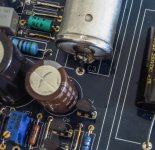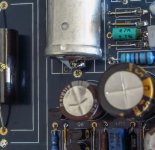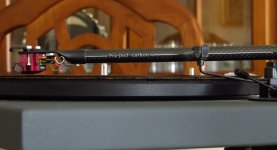Thanks Salas,The Ortofon 2M RED is rather toned down for treble in my view and entry level for resolution in general. In such a case silver mica can come across like spicing things up. Most MM rely on an electrical tank circuit to bump up beyond 12kHz after a downwards slide in the response. With the 10X5 on just 150 Ohm motor as signal source you will probably find polysterene or tin+polystyrene film & foil smoother and cleaner than silver mica for the C2Y, its value you may need change also. But try both types for yourself since each system as a whole has its own traits. I have 10X4 MKII and had auditioned 10X5 several times too, they are evenly balanced but not edgy. Resolution and dynamics are much purer than with the 2M RED. Response is naturally extended and flat enough too.
Any suggestions for polysterene or tin+polystyrene film & foil?
For polysterene you could get Milspec or normal NOS 100pF, 150pF, 200pF (allx2) on ebay or PCX, Collective etc. Or 100pFx4 and 50pFx2 to add step by step to listen without desoldering the first one. 120pF, 82pF, 68pF, 33pF, 27pF are easy to come up with combinations too. Do not need be high voltage. Any parts 25V or more. 5% tolerance will suffice since they are a small portion of the C2+C2Y total but 2% is even nicer if you find any. For film & foil things get tougher as its on rare NOS German ones. I would not go there before I knew the final C2Y value of choice. So to try find only two.
Meantime, did rclourenco receive his 10X5 yet, did nezbleu tone down his Denon's hf without resolution loss, did skouliki find the right ketchup to clean his tarnished NOS caps legs? Questions run deep.
No, I haven't installed the additional C2y caps yet. Partly busy/lazy, partly because I keep listening, and I'm not 100% certain it needs it. Some days it sounds perfect as-is. I expect some records are hotter than others. Also, perhaps the cart is still "running in" a bit, changing subtly. Or maybe I'm getting used to it.
A while ago I ordered one of those inexpensive digital scales, and it arrived yesterday. Today I measured the VTF, and it was a bit high. It's supposed to be 1.5g +/-0.3, but it measured 1.95. I turned it down a bit to around 1.6g (I'm still using the spring in the RB300, maybe I'll try the counterweight-only method too). I haven't had a chance to listen since changing the VTF. I need to get one of those test records; maybe my local shop (Taz Records : Atlantic Canada's Largest Music Store) carries them, or maybe I'll have to order on-line.
Here's a quick question about use of those little digital scales. (I got this one.) I think the tray is magnetic, by which I mean is affected by magnets. So I set it on the platter and it reads 0, then I swing the tonearm over so the cartridge is just above it but not touching, and the display reads negative (like -0.04g or something). So I assume the magnet in the cart is pulling the tray upwards. Now: how does that effect the reading when I lower the stylus onto the platform? Will it still read low? Will it read a bit high because the tray is attracting the cartridge, pulling it down? Or, since it is pulling the cart to the tray, but not to the surface below the tray, might it have no effect? I have decided to use a block of melamine foam ("Magic Eraser") to keep the cartridge body away from the tray, and clean the stylus at the same time!
Last edited:
You also had a mechanical scale before or you were only based on the RB300 indication? That digital scale should be much more accurate than what the arm roughly suggests and expect a big change in sound if you were +0.45g heavy indeed. Not just heavy but beyond max spec heavy.
It should pull a little magnetically when above, but when landed it should push enough not to let the tray leave its zero plane relative I would suppose from the top of my head but I am illiterate in mechanics so somebody else may come up with a better answer.
It should pull a little magnetically when above, but when landed it should push enough not to let the tray leave its zero plane relative I would suppose from the top of my head but I am illiterate in mechanics so somebody else may come up with a better answer.
Sure, it will be the first time you will listen to it properly actually. By the way I just read the reviews on that scale and all 13 were written by turntable users stating it does the job perfectly so if its something lost in the magnetic thing it should be tiny. On the other hand if the arm will stand much tilting back due to some buffer distance material to avoid the magnetic pull idea, it will exert less pressure at the tip than with its front end normally set nearer to the plane of the record, will it not?
I thought of that: I can put the scale on the plinth, and cut a block of foam so the top of it , when resting on the scale, is even with the top of the platter.
He, he, you can't beat a scholastic.
I suspect that any effect due to correcting +0.45g error on a 1.5g spec cart will be maximal. Happy listening soon and let us know.Or an obsessive-compulsiveI suspect that any effect due to magnetic attraction will be minimal.
Did you see any diamond photos from that ex demo 10X5 you are expecting by the way? Is it coming from a reputable source so to be returnable, thus free of worries about claimed 100hrs use are true and being wear free?
No I didn't, but it's coming from a reputable seller which mostly deals on carts. I have already x-fingers

Meantime, did rclourenco receive his 10X5 yet, did nezbleu tone down his Denon's hf without resolution loss, did skouliki find the right ketchup to clean his tarnished NOS caps legs? Questions run deep.
Well i did try the hot ketcup variant which i readily had in the fridge
It removed some of the corrosion , but impatient that i am i used the metal head of a large screwdriver to gently remove the corrosion in the spot i wanted to solder. Maybe next time i'll use the plain ketchup
Today i think im going to adjust the VTA of the tonearm which seems to me , to be way off
Attachments
I used 3 different caps in c3: philips axial polystyrene, obbligatto copper and the latest ft-2 teflon. Different presentation for each. The philips polystyrene was neutral , obbligatto was "warmer" and FT2 has the best resolution out of the rest but is also pleasant. I prefer FT2 but could also live happily with the rest as well
Only point of attention, if used in high gain setting builds, bcs their metal jackets are floating they may attract hum. But attaching a wire from their barrel to some handy GND node, largely solves it. In no case any conductive jacket cap should be allowed touching unused pads underneath it let's remind to any prospective users by the way.
You got 43dB which is safe. If you touch them when the volume is cranked up can you hear some little hum for instance? That's only an experiment of course, what matters is they are not adding hum normally. Not even touching maybe is audible before LMC mode gain. My PTG/II puts out less than 0.25mV across 200 Ohm on the 5cm/sec Telarc Omnidisc 0dB ref track for instance. I use 20dB more gain on 94dB/W speakers. Imagine how any susceptibility becomes much more of a sudden problem.
You got 43dB which is safe. If you touch them when the volume is cranked up can you hear some little hum for instance? That's only an experiment of course, what matters is they are not adding hum normally. Not even touching maybe is audible before LMC mode gain. My PTG/II puts out less than 0.25mV across 200 Ohm on the 5cm/sec Telarc Omnidisc 0dB ref track for instance. I use 20dB more gain on 94dB/W speakers. Imagine how any susceptibility becomes much more of a sudden problem.
Come to think of it, i didnt touch the cap. I will try that and see. And an off topic question: What are your speakers?
43dB is 141 times magnification. 63dB is 1410 times magnification. Wow, imagine if there is dirt on that lens. Still amazing how chisel carving a master then stamping it on a cheap plastic then dragging a rock on it then zooming out hard on its hand waving and EQing at the same time plays any legible music at all.
- Home
- Source & Line
- Analogue Source
- Simplistic NJFET RIAA




 Rclourenco was keen to know on using FT there BTW. I am sure he expects your opinion now.
Rclourenco was keen to know on using FT there BTW. I am sure he expects your opinion now.